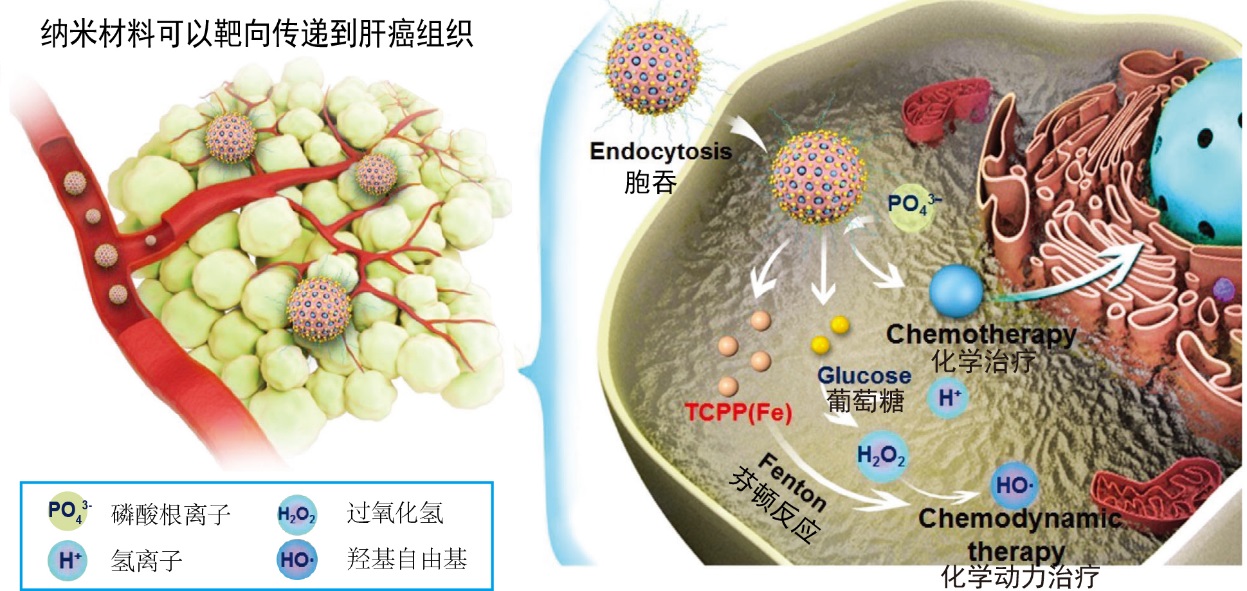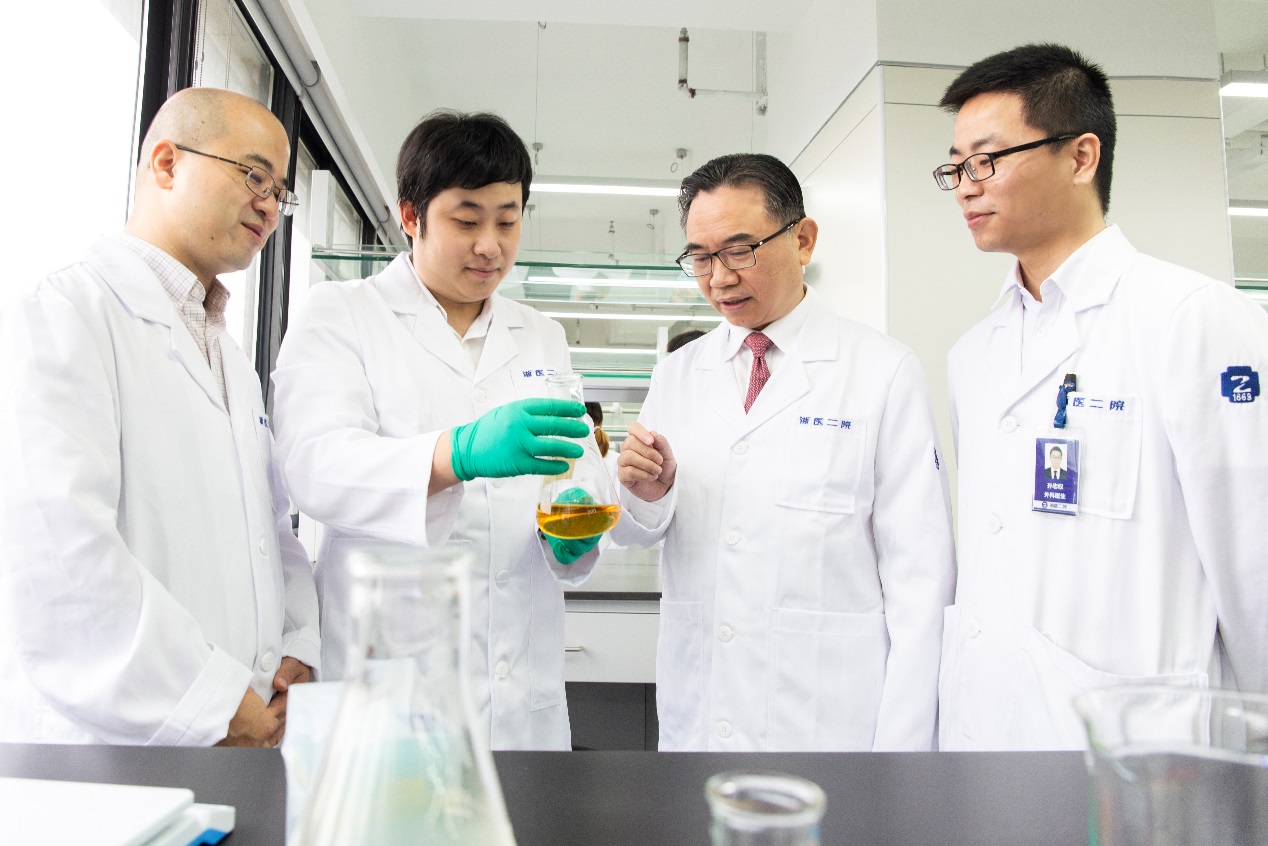ZJU scientists fabricate a hybrid nanomedicine for liver cancer
Liver cancer is the seventh most common cancer and its mortality rate is the third highest. In China, approximately 330,000 people die of liver cancer every year, accounting for 42% of the world’s total death toll. Due to the fact that liver cancer is insidious, upon diagnosis, most patients will be found to be terminally ill and therefore lose the prime time of surgical treatment. Thus, comprehensive treatment, including intervention therapy and chemotherapy, offers the only ray of hope to the majority of terminally ill patients.
However, poor drug delivery, unsatisfactory antitumor performance, severe side effects, and drug resistance immensely impair the clinical outcome of comprehensive treatment. In recent years, there have emerged a variety of novel therapies, among which chemodynamic therapy (CDT) is one of the most promising. CDT can catalytically convert intracellular hydrogen dioxide (H2O2) into highly toxic reactive oxygen species (ROS) through therapeutic reactions, especially Fenton‐like reactions. It is characterized by its non-toxicity and exceptional targeting ability. Nevertheless, insufficient endogenous H2O2 in the tumor issue inhibits the efficacy of CDT considerably.

The research team led by Prof. WANG Weilin from the Zhejiang University Second Affiliated Hospital and the research team led by Prof. MAO Zhengwei from the Zhejiang University Department of Polymer Science and Engineering engaged in pioneering research into the possibility of fabricating a hybrid nanomedicine (Au/FeMOF@CPT NPs) using metal-organic framework (MOF) nanoparticles and gold nanoparticles (Au NPs) as building blocks for cancer chemo/chemodynamic therapy. Their research findings are published in an open access form in the Advanced Science.
Find a “backup” and hit the target head-on
One of the flaws with chemotherapy is that conventional drugs are susceptible to interference in the complex human environment and can be “detonated” before reaching the tumor.
The explosive growth of liver cancer requires a massive amount of energy which comes from glucose in the microenvironment of liver cancer. Scientists have long been employing this principle to hold back and slow down the growth of liver cancer. With persistent and determined efforts, scientists have eventually discovered a kind of “tumor sentinel”: glucose oxidase (GOx). GOx can “sniff out” and consume glucose to inhibit the tumor growth. This is known as GOx-based starvation therapy.
As a common protein in the human body, GOx can be easily spoiled. A suite of factors, such as heavy metals, high temperature, solvents, and acid and alkaline conditions, can easily make it inactive and ineffective. Once entering the human body, it will be rendered inactive by an appreciable number of proteases in blood and tissues.
Can scientists find a substance to replace this “precious” GOx? ZJU researchers have discovered gold nanoparticles with protease-like catalytic properties, which can not only effectively penetrate the depths of liver cancer, but efficiently catalyze glucose in liver cancer tissues, thereby killing hepatic cells via “starvation therapy.”
Put on the “armor” and ride on the “waves”
In the past, the effect of “starvation therapy” was confined for the most part to hampering and slowing down the growth of liver cancer, so liver cancer couldn’t be utterly cured. Then what is a real antidote to liver cancer?
Hepatic cells tend to accumulate more H2O2 than normal ones. Through the action of catalysts (usually iron ions), H2O2 produces toxic hydroxyl that can kill hepatic cells, a therapy known as CDT.
The drugs used in traditional chemotherapy are toxic. They are either eliminated in the blood circulation process or inclined to attack healthy tissues. However, CDT is non-toxic per se and only produces toxic substances in specific regions to kill “targeted” tumor cells.
Unfortunately, there is a paucity of endogenous H2O2 in hepatic cells. Once it is depleted, there will be another proliferation of tumor cells. In the past, scientists have endeavored to provide exogenous H2O2, but the “traffic condition” around the tumor tissue is very complicated, thus making it difficult to supply the tumor with H2O2 in a precise manner. Moreover, H2O2 is a hazardous chemical which can easily “leak out” on the way and damage normal tissues, therefore causing serious side effects.

To tackle this key question, ZJU scientists fabricated MOF nanoparticles (FeMOF NPs) featured by their porous structure, which can be decomposed rapidly thanks to the action of a special microenvironment after reaching the tumor region and release iron ions for CDT. Meanwhile, to achieve precise drug delivery, researchers used the MOF structure and specific organic molecules to encapsulate gold nanoparticles like the “armor”. Gold nanoparticles will be exposed only in the tumor microenvironment and play a crucial role in breaking down glucose and killing hepatic cells.
Researchers integrated “starvation therapy” into CDT seamlessly. “Starvation therapy and CDT are a natural ‘couple’, which can achieve a cascade of chemical reactions. Through glucose oxidation, they can produce H2O2 incessantly which fuels the Fenton reaction. This ‘synergy’ can achieve an ideal therapeutic effect and can be lauded as a “golden partner’ of liver cancer treatment,” said Prof. WANG Weilin.
The exciting prospect of nano-cancer drugs
The ZJU research team combined the treatment of the symptoms and the root cause of liver cancer by creating a “nano-ark” so that the anti-liver cancer drug could have a better carrier to navigate through the complex human system to reach the foci of liver cancer.
“There is compelling evidence in both in vitro and in vivo experiments that the fabricated hybrid nanomedicine has a marked effect in containing liver cancer. In contrast with traditional chemotherapy drugs, the systemic toxicity of this drug can be enormously reduced,” said Prof. MAO Zhengwei.
This nanomedicine improved the drug delivery efficiency of chemotherapy drugs and brings in its wake novel therapeutic methods. “Nanotechnology, as a bridge between two classical therapies, has realized the ‘relay race’ against cancer,” MAO Zhengwei remarked.
According to the researchers from the ZJU Second Affiliated Hospital, the clinical application of this nanomedicine may well resolve a host of thorny problems with existing chemotherapy drugs in a convenient way. On the one hand, it merges the advantages of two anti-cancer therapies and nanoparticles. Not only can it kill hepatic cells directly, but it can also curb the growth of surviving cells, thereby remarkably boosting the possibility of liver cancer being cured. On the other hand, nano-materials can be targeted to function only in liver cancer tissues without attacking other normal tissues. They can produce a powerful killing effect on liver cancer, but with mild adverse effects.
What is more noteworthy is that, in addition to systemic chemotherapy, this medicine can also play a vital role in intervention therapy and surgery. It can remove some early liver tumors with multiple metastases through local injection. Furthermore, the application of this drug together with the surgical removal of some tiny and hidden lesions that can only be spotted during surgery can maximize the cure of liver cancer and minimize the possibility of recurrence.
